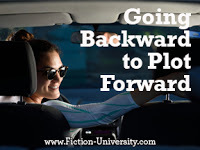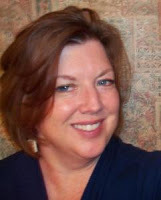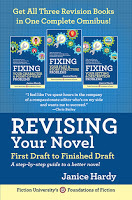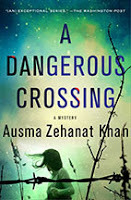Janice Hardy's Blog, page 114
February 22, 2018
10-Great Strategies to Secure & Monetize Your Author Visit
 By Jaimie Engle, @theWRITEengle
By Jaimie Engle, @theWRITEenglePart of the Indie Author Series
Author visits are a great way to build your brand and cushion your cash-flow. If you are a good speaker, you can:
Teach at conferences Speak at community events Share at school visits Keynote at all of the above
Read more »Written by Janice Hardy. Fiction-University.com

Published on February 22, 2018 04:44
February 21, 2018
A Handy Tip for Crafting a Seamless Plot
 By Janice Hardy, @Janice_Hardy
By Janice Hardy, @Janice_Hardy When it comes to writing, I’m a plotter. I like to figure out my story and how it will unfold before I ever start writing. But I’m also a pantser when it comes to characters. I do little work on them beforehand, and prefer to discover who they are as I write.
Because of this, I’m constantly running into moments where my characters say or do things that have zero groundwork in the draft to support them.
They have feelings about the problem they didn’t have at first. They have resources or skills that didn’t appear before. They reveal backstories I had no idea existed.
Read more »Written by Janice Hardy. Fiction-University.com

Published on February 21, 2018 05:57
February 20, 2018
How Shame and Vulnerability Can Connect Us to Characters
 By Bonnie Randall
By Bonnie Randall Part of the How They Do It Series (Monthly Contributor)
Brene’ Brown said “If we can share our story with someone who responds with empathy and understanding, shame can’t survive.”
Hold onto that quote. It is going to be an important anchor as we dive into some character analysis and contrasts between two highly successful pieces of Domestic Noir: Gone Girl by Gillian Flynn, and The Wife Between Us by the literary team of Greer Hendricks and Sarah Pekkanen.
Each of these novels has much to be proud of, and each has an enthusiastic fan base. For the purposes of this article—on how shame and vulnerability can connect us to characters—it will be very clear that one of these novels just didn’t cut it for me. In that, I beg you to remember that reading is a subjective experience, and that my opinion is merely one grain of sand on an endless beach.
Now here we go.
Read more »Written by Janice Hardy. Fiction-University.com

Published on February 20, 2018 03:00
February 19, 2018
The Difference Between a Revision, a Rewrite, and a Redraft
 By Janice Hardy, @Janice_Hardy
By Janice Hardy, @Janice_Hardy Before I dive in…I’m guest posting over at Writers in the Storm today, talking about The Benefits of Writing a Novel “Just for Fun.” Come over over and say hello.
My current work in progress is one I keep going back to. It’s been written, revised, and redrafted more times than I care to count, and as I’m doing yet another pass on it, I realized I approach it differently depending on what “stage” it’s in.
I have multiple drafts and plotlines of this novel, so I have dozens of favorite scenes and subplots. I have beloved characters who have appeared in one version, but not another. I even have versions where I cut one point of view character out entirely.
Read more »Written by Janice Hardy. Fiction-University.com

Published on February 19, 2018 06:12
February 18, 2018
Writing Prompt: The Free Write: Moving On
 By Janice Hardy, @Janice_Hardy
By Janice Hardy, @Janice_Hardy This week’s prompt is a free write, so take the seed below and run with it. It doesn’t have to turn into anything (unless you want it to, of course), just let the words flow and see where they go.
Write down this opening sentence and follow it wherever it goes:
Moving boxes was the last thing...
Write as much or as little as you’d like. Written by Janice Hardy. Fiction-University.com

Published on February 18, 2018 03:26
February 17, 2018
Real Life Diagnostics: Is it Clear What's at Stake?
 Critique By Maria D'Marco
Critique By Maria D'Marco Real Life Diagnostics is a weekly column that studies a snippet of a work in progress for specific issues. Readers are encouraged to send in work with questions, and we diagnose it on the site. It’s part critique, part example, and designed to help the submitter as well as anyone else having a similar problem.
If you're interested in submitting to Real Life Diagnostics, please check out these guidelines.
Submissions currently in the queue: One
Please Note: As of today, RLD slots are booked through February 24.
This week’s questions:
Is it clear on what's at stake? Do you start to get a feel for the character? Would you want to read more?
Market/Genre: Fantasy
On to the diagnosis…
Read more »Written by Janice Hardy. Fiction-University.com

Published on February 17, 2018 03:00
February 16, 2018
Five Traits to Help You Create Your Character's Personality
 By Janice Hardy, @Janice_Hardy
By Janice Hardy, @Janice_Hardy This week's Refresher Friday takes another look at using established personality traits to help us build well-rounded characters.
Creating a character is more than choosing a name and making a list of physical details. Who they are and how they act plays a much stronger role in how a novel unfolds than what they look like. There are dozens of ways to develop the inner depths of a character, and one way is by understanding their personality.
Psychologists over the last sixty years have broken personality down into five traits that influence how a person interacts with the world. These traits can be beneficial to writers, helping us determine how our characters might interact with our story worlds.
Read more »Written by Janice Hardy. Fiction-University.com

Published on February 16, 2018 03:00
February 15, 2018
3 Ways to Get Book Covers on a Shoestring Budget
 By J. Kathleen Cheney, @jkcheney
By J. Kathleen Cheney, @jkcheney Part of the Indie Authors Series
JH: Another new indie author is joining the faculty this month! Please help me welcome J. Kathleen Cheney, who'll share her tips and thoughts on indie publishing this week every other month.
J. Kathleen Cheney taught mathematics ranging from 7th grade to Calculus but gave it all up for a chance to write stories. Her novella “Iron Shoes” was a 2010 Nebula Award Finalist. Her novel, The Golden City was a Finalist for the 2014 Locus Awards (Best First Novel). Dreaming Death (Feb 2016) is the first in a new world, with the books of The Horn coming out in 2017, and the sequels to Dreaming Death in 2018
Website | Goodreads | Facebook | Twitter | Tumblr |
Take it away JK...
Read more »Written by Janice Hardy. Fiction-University.com

Published on February 15, 2018 04:47
February 14, 2018
Three Ways to Making “Revising Your Novel” Easier
 By Janice Hardy, @Janice_Hardy
By Janice Hardy, @Janice_Hardy I’ve been a busy gal lately. Not only have I released a new novel ( Blood Ties ), I’ve also made some changes to my writing books.
Based on the popularity of my targeted writing guides (such as Understanding Show, Don’t Tell and Understanding Conflict ), and at the requests of writers and readers, I’ve applied the same concept to my Revising Your Novel: First Draft to Finished Draft . It’s now easier to get the exact help you need for your manuscript.
For those who still want one compete guide to revising their novel, the original Revising Your Novel is now an omnibus containing the full “series.” But for those who just want to work on a particular area, you now have three, targeted options:
Read more »Written by Janice Hardy. Fiction-University.com

Published on February 14, 2018 05:10
February 13, 2018
Dealing with a Tricky Technique: Research Hills to Die On
 By Ausma Zehanat Khan, @ausmazehanat
By Ausma Zehanat Khan, @ausmazehanat Part of the How They Do It Series
JH: Researching a novel is a lot of fun, and a lot of work. But the work is worth it when a story comes to life before our eyes. Ausma Zhanat Khan visits the lecture hall today to share some tips on researching your story. Let's give her a warm welcome.
Ausma Zehanat Khan is the author of the award-winning debut novel The Unquiet Dead , the first in the Khattak/Getty mystery series. Her subsequent novels include the critically acclaimed The Language of Secrets and Among the Ruins . Her latest mystery in the series is A Dangerous Crossing . The Khattak/Getty mystery series has been optioned for television by Lionsgate, and Ausma is also the author of a fantasy series for Harper Voyager. The Bloodprint, Book One of the Khorasan Archives was published in October 2017. Ausma holds a Ph.D. in international human rights law with a specialization in military intervention and war crimes in the Balkans. A British-born Canadian and former adjunct law professor, she now lives in Colorado with her husband.
Website | Goodreads | Facebook | Twitter |
Take it away Ausma...
What Do You Want to Write About
I write contemporary crime novels and what I like to call alternate future fantasy, and both my series require a great deal of research, though each is quite different in what it demands to make the books seem grounded in a world that is familiar. My crime series focuses on global human rights issues, and so the bulk of my research time is allocated to finding out more about the issues I want to write about. In the past, these have included the dissolution of Yugoslavia and the Bosnian genocide, the detention of political prisoners in Iran, and most recently, the refugee crisis flowing from the war in Syria.
As a writer who grew up in Canada and now lives in Colorado, these are not places or subjects I know firsthand, though I do have a background in human rights law. But these are the subjects that inspire me—they draw me into a world that I think is important and that I want to know more about, so when I figure out what topic I want to write about, I focus my research there.
What to Read and How to Make it Stick
With research, the first step is always to read, and I aim for a balance of non-fiction and fiction. Non-fiction is essential for getting a clear grasp of the facts, but it can be tricky to figure out what to read from an often overwhelming body of information. I start with news reports—the BBC country summaries really help in that regard, and from there I’ll find links to other articles and sources. I also pull up human rights country reports, so I have clear reporting on what’s happening on the ground.
With my book, A Dangerous Crossing, which is about the war in Syria, for example, I read several searing Human Rights Watch reports on the subject of political dissidents inside the country. This material is immensely difficult to read, but what it offers is the direct testimony of survivors—which in turn helps me understand the story I want to write, as well as putting me inside the heads of people who have lived this reality.
It quickly becomes clear that when you’re telling these kinds of stories, you have a responsibility to get the story right. I’ll also read many of the leading books in the field, but then the real challenge is to sort out that material and figure out what the story needs, and what is simply of personal interest.
Whatever subject you’re tackling in your book—from technology to home gardening, from deathless love to a secret sisterhood of witches—the more you know about it, the more it will make itself a valuable part of your book.
Remember that You’re Writing Fiction
Research into fiction. I have to remind myself of this all the time, especially because I have an academic background and can easily get lost in minutiae that is fascinating for me, but not necessarily for anyone else. Reading novels and poetry that speak to the same subject always form the other half of the equation for me. Facts are one thing, but how people are affected them and what they think about their own reality, is equally vital to telling a story with depth. So the key is to collect, winnow down, and decide what’s made a real impact—and then to begin from there.
I usually find that I want to throw everything I’ve read into the book, but I’ve learned to accept the wisdom offered by editors who tell me that less is more, and that the story needs to breathe. Are there false starts? Absolutely. Have I sometimes cut 25,000 words that I personally found fascinating about a royal treasure or the various types of lifeboats out at sea? Definitely. But the value of reading so widely is that I always come across something new that really breathes life into my books.
Interviews – Ask and You Shall Receive
Writers spend a lot of time alone, locked inside their minds, so another tool I’ve found really helpful is the ability to conduct interviews with people who are kind enough to share their insights and their time. They may be experts in a particular field, or they may be people with firsthand experience about things you want to write about in your book. But how do you find these people?
I think most writers have a real curiosity about the world, so whenever I meet people, I like to learn about their histories, the journeys they’ve taken, and the things they consider important. Social media, particularly Twitter, has also helped me reach out to contacts and ask if they’re willing to answer my questions.
In my case, a lot of the things I want to ask are very sensitive and are usually painful for my interviewees to speak about. For example, I’ve interviewed former political prisoners from Iran, and refugees from Bosnia and Syria. In cases like these, it’s important to build trust, and to listen more than you speak—people are sharing some of the most traumatic moments of their lives, and it’s important to treat that with utmost respect. You’ll often need to take breaks in the conversation, or let the person you’re speaking to determine where the conversation should go.
It’s also important to be clear about why you’re asking for the interview, and how you will use the information you’ve been given. I’ve met some of the most inspirational people through this process, and their words breathe through my books.
Travel – All the World in A Book
Travel is undoubtedly my favorite part of the research process, though it can also be prohibitively expensive. So rather than just travel for work, I plan my vacations so that the locales coincide with what I want to explore in my books. It takes a lot of foresight and scrimping and saving to do this, but the rewards are immeasurable in terms of how they enrich the sensory experience of my books.
My fantasy series is set in Central and South Asia, as well as the Middle East, and nothing made as big of an impact on those books than my once-in-a-lifetime opportunity to visit the fabled cities of the Silk Road. But just as often, I can’t afford a trip, or I don’t think it’s a safe place to visit, and in that case, I have the following tools at my disposal:
Online photography: For my book on Iran, I looked at thousands of local photographs, and they were indispensable to setting the scene. Videos: Everything from YouTube clips to PBS or BBC documentaries. Travelogues and the Travel ChannelPeople: And if I’m lucky enough, I’ll meet someone who will let me take a stroll down memory lane by canvassing their personal photographs. Are You Ready to Write?
Do you need to do all of these things to write a book that feels grounded in truth? This is just the research process that works for me. As deadline pressures increase, and I end up in more of a time crunch, I can no longer read as widely as I used to, and I’m often gathering snippets on the sly. But as I’m sure you know, no experience or observation is wasted on writers, so some mix of the techniques I’ve listed—with the balance falling differently each time—helps me take a subject that seems vast and daunting and focus it into the story I want to tell.
Do you have any research tips to share?
About A Dangerous Crossing
 For Inspector Esa Khattak and Sergeant Rachel Getty, the Syrian refugee crisis is about to become personal. Esa’s childhood friend, Nathan Clare, calls him in distress: his sister, Audrey, has vanished from a Greek island where the siblings run an NGO. Audrey had been working to fast-track refugees to Canada, but now, she is implicated in the double-murder of a French Interpol agent and a young man who had fled the devastation in Syria.
For Inspector Esa Khattak and Sergeant Rachel Getty, the Syrian refugee crisis is about to become personal. Esa’s childhood friend, Nathan Clare, calls him in distress: his sister, Audrey, has vanished from a Greek island where the siblings run an NGO. Audrey had been working to fast-track refugees to Canada, but now, she is implicated in the double-murder of a French Interpol agent and a young man who had fled the devastation in Syria. Esa and Rachel arrive in Greece to a shocking scene, witnessing for themselves the massive fallout of the Syrian war in the wretched refugee camps. Tracing Audrey’s last movements, they meet some of the volunteers and refugees―one of whom, Ali, is involved in a search of his own, for a girl whose disappearance may be connected to their investigation. The arrival of Sehr Ghilzai―a former prosecutor who now handles refugee claims for Audrey’s NGO―further complicates the matter for Esa, as his feelings towards her remain unresolved.
Working against time, with Interpol at their heels, Esa and Rachel follow a trail that takes them from the beaches of Greece, to the Turkish–Syrian border, and across Europe, reaching even the corridors of power in the Netherlands. Had Audrey been on the edge of a dangerous discovery, hidden at the heart of this darkest of crises―one which ultimately put a target on her own back?
Amazon | Barnes & Noble | Indie Bound | Kobo | Written by Janice Hardy. Fiction-University.com

Published on February 13, 2018 04:57



